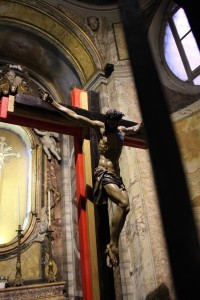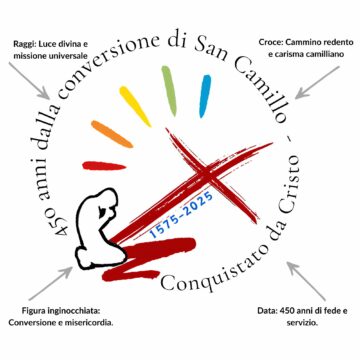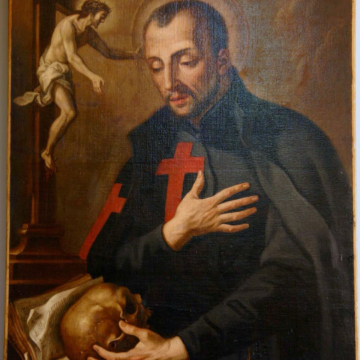 In the heart of ancient Rome, near the Mausoleum of Augustus and the Ara Pacis. The Order of the Ministers of the Infirm arose just here. Among the oldest hospitals arisen in the Middle Ages in Rome, it is also called St. James “in Augusta” (the region was named this way for the presence of the mausoleum of Emperor Augustus). It was built for care of the executors of the deceased Cardinal Pietro Colonna’s last will in 1326.
In the heart of ancient Rome, near the Mausoleum of Augustus and the Ara Pacis. The Order of the Ministers of the Infirm arose just here. Among the oldest hospitals arisen in the Middle Ages in Rome, it is also called St. James “in Augusta” (the region was named this way for the presence of the mausoleum of Emperor Augustus). It was built for care of the executors of the deceased Cardinal Pietro Colonna’s last will in 1326.
The presence of St. Camillus
 St. Camillus stays three times at the St. James Hospital. The first time since March 7 to December 31, 1571: still a soldier of fortune, he comes here to cure the famous wound at the foot that will not abandon him for a lifetime. First hospitalized, then hospital attendant, he will be expelled for reckless conduct. From October 23, 1575 to June 20, 1579, after the conversion, which occurred February 2, 1575 on the road from San Giovanni Rotondo to Manfredonia, he returns to the St. James Hospital because the wound is open again under the rub of the coarse habit of the Capuchins, among whom he has been able to enter. Once back healed he comes back to the sons of St. Francis, although St. Philip Neri, his confessor, tells him that his place is there and that soon he will return. From mid-October 1579 to September 1, 1584: during this time he holds the office of Master of the House, he starts the congregation and becomes a priest (he celebrates his first Mass in the Church of St. James, June 10, 1584). His goal is to free the infirm from the mercenaries’ hands and to establish a company of “honest and pious men,” which not for money but for love of God would serve and treat them with charity and with the love of a mother that assists his only ill son. It is still in this period that Camillus thinks of the big red cross for the robe of the members of the Fellowship.
St. Camillus stays three times at the St. James Hospital. The first time since March 7 to December 31, 1571: still a soldier of fortune, he comes here to cure the famous wound at the foot that will not abandon him for a lifetime. First hospitalized, then hospital attendant, he will be expelled for reckless conduct. From October 23, 1575 to June 20, 1579, after the conversion, which occurred February 2, 1575 on the road from San Giovanni Rotondo to Manfredonia, he returns to the St. James Hospital because the wound is open again under the rub of the coarse habit of the Capuchins, among whom he has been able to enter. Once back healed he comes back to the sons of St. Francis, although St. Philip Neri, his confessor, tells him that his place is there and that soon he will return. From mid-October 1579 to September 1, 1584: during this time he holds the office of Master of the House, he starts the congregation and becomes a priest (he celebrates his first Mass in the Church of St. James, June 10, 1584). His goal is to free the infirm from the mercenaries’ hands and to establish a company of “honest and pious men,” which not for money but for love of God would serve and treat them with charity and with the love of a mother that assists his only ill son. It is still in this period that Camillus thinks of the big red cross for the robe of the members of the Fellowship.
What remains
 Here was located the Crucifix, presented in the first tab (Church of St. Mary Magdalene), that encourages St. Camillus twice to continue his mission of service to the infirm. There aren’t any other traces of St. Camillus’ presence inside the hospital, although he resided there for more than nine years in the course of his life.
Here was located the Crucifix, presented in the first tab (Church of St. Mary Magdalene), that encourages St. Camillus twice to continue his mission of service to the infirm. There aren’t any other traces of St. Camillus’ presence inside the hospital, although he resided there for more than nine years in the course of his life.
To see
Hospital Building: very little survives of the early fourteenth-century construction of the St. James. It all boils down to a portal of beautiful workmanship, very similar to what’s at St. John’s Hospital, both portals executed in 1350, and, as it seems, thanks to the Colonna Cardinals. The portal of St. James is simpler than the Lateran, severe, with the noble shield of the Colonna (the column), a crown that looks marchesal, abreast a mitre from which the sacred wimples hang. There is not the Cardinal’s hat, perhaps because the arch was built by his nephew James, Bishop of Lombez, son of Stephen Colonna, which housed Petrarch in his palace. Since 1955 the Camillians are back in this Hospital taking the Pastoral Service. In the four hundredth anniversary of the Conversion of St. Camillus (1575-1975) they were able to embed a plaque in memory of the presence of the Holy Founder within these walls.
 Church of St. James: it has the facade on Via del Corso, but also a small entrance on the first courtyard of the Hospital, next to the apse. Rebuilt and enlarged in 1592, it was designed by architect Francis Capriani of Volterra, a pupil of Michelangelo. The work was completed in 1602 by Charles Maderno, his nephew and Domenico Fontana’s pupil. Camillian sacred place of considerable importance, because here you can relive a great event of the Saint’s life: he celebrated here, in fact, his first Mass, on June 10, 1584, just in the altar of the Madonna.
Church of St. James: it has the facade on Via del Corso, but also a small entrance on the first courtyard of the Hospital, next to the apse. Rebuilt and enlarged in 1592, it was designed by architect Francis Capriani of Volterra, a pupil of Michelangelo. The work was completed in 1602 by Charles Maderno, his nephew and Domenico Fontana’s pupil. Camillian sacred place of considerable importance, because here you can relive a great event of the Saint’s life: he celebrated here, in fact, his first Mass, on June 10, 1584, just in the altar of the Madonna.
St. Mary Portae Paradisi: little church embedded in the isolate of the St. James Hospital, from which it is accessible. Already known in the eleventh century with the name of St. Mary in Augusta, it had the title “in Porta Paradisi” or just “Portae Paradisi” because near there it opened one of the doors of the walls that surrounded the nearby Mausoleum of Augustus, called paradiseiois, or because there was the cemetery next to the St. James Hospital. Certainly, the Saint went to the church to pray, because of his devotion to the Immaculate Mother of God
Nearby
 Via del Corso: chiamata comunemente il Corso, è una nota strada del centro di Roma che collega piazza Venezia a piazza del Popolo e misura all’incirca 1,6 chilometri.
Via del Corso: chiamata comunemente il Corso, è una nota strada del centro di Roma che collega piazza Venezia a piazza del Popolo e misura all’incirca 1,6 chilometri.
Piazza del Popolo: è una delle più celebri piazze di Roma, ai piedi del Pincio. La forma della piazza assume la conformazione attuale solo alla fine del XIX sec. Precedentemente era una modesta piazza di forma trapezoidale, che si allargava verso il Tridente. Al tempo dell’occupazione napoleonica, infatti, l’aspetto architettonico ed urbanistico della piazza venne rivisto dall’architetto neoclassico Giuseppe Valadier. Si trovano qui la chiesa di Santa Maria del Popolo e le due chiese gemelle Santa Maria in Montesanto (1675) e Santa Maria dei Miracoli (1678). Da ammirare, inoltre, la Porta del Popolo e le fontane, fra cui quella centrale sormontata da un enorme obelisco.
Dall’Ospedale San Giacomo si prosegue verso Piazza del Porto di Ripetta: si raggiunge facilmente a piedi, tornando indietro su via di Ripetta all’altezza di Ponte Cavour (450 m).
 From Termini station take metro A, direction Battistini, get off at Flaminio (Piazza del Popolo) and continue on foot
From Termini station take metro A, direction Battistini, get off at Flaminio (Piazza del Popolo) and continue on foot
From Tiburtina station take metro B in the direction of Laurentina, get off at Termini and take metro A, get off at Flaminio (Piazza del Popolo) and continue on foot.
Metro A Flaminio (Piazza del Popolo) and continue on foot (c. 250m): continue along Via del Corso until the crossroads with Via Antonio Canova. The hospital is at n. 29. From the metro stations S. Giovanni and Spagna (metro A) and Colosseo (metro B) continue with bus number 119. From Piazza Venice and Torre Argentina bus number 119.










